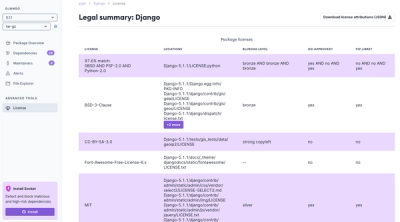
Product
Introducing License Enforcement in Socket
Ensure open-source compliance with Socket’s License Enforcement Beta. Set up your License Policy and secure your software!
Project contains abstraction of pymongo driver for automatic reconnect on master switch in remote MongoDB cluster. It
also provides data definition layer.
Core of mongo_driver is the Engine class, handling queries reconnection with notification to registered reconnect
hooks.
Database creates Collections by their definitions. Database hooks itself to engine reconnect event, so it can switch
internal state of database's collections instances.
classDiagram
Executor <|-- Engine : implements
Database o-- Executor
Database *-- Collection
Database o-- CollectionDefinition
Collection o-- Executor
CollectionDefinition *-- Index
CollectionDefinition *-- Document
class Executor{
<<abstract>>
reconnect()
register_hook(reconnect_hook_func)
find_one(collection: pymongo.collection.Collection, ...)
other_collection_methods(collection: pymongo.collection.Collection, ...)
}
class Engine{
+client: MongoClient
-_retry_command(collection, command, ...)
dispose()
reconnect()
register_hook(reconnect_hook_func)
find_one(collection: pymongo.collection.Collection, ...)
other_collection_methods(collection: pymongo.collection.Collection, ...)
}
class Collection{
+dialect_entity: pymongo.collection.Collection
+engine: Executor
+find_one(...)
other_collection_methods()
}
class Document{
+unique_key: Optional[BsonDict]
+data: BsonDict
}
class CollectionDefinition{
+name: str
+indices: Sequence[Index]
+default_docs: Sequence[Document]
}
class Index{
+fields: OrderedDictType[str, Union[str, int]]
+name: Optional[str]
+unique: Optional[bool]
field_for_mongo() -> List[Tuple[str, Union[str, int]]]
}
class Database{
+engine: Executor
+topology: List[types.CollectionDefinition]
-_database: pymongo.database.Database
-_collections: Dict[str, Collection]
invalidate_cache_hook(source: Engine)
get_collection(name: str) -> Collection
extend(*new_definitions: types.CollectionDefinition)
create_all(skip_existing: bool)
ping() -> bool
}
Within a particular ecosystem, there may be a common way of installing things, such as using Yarn, NuGet, or Homebrew. However, consider the possibility that whoever is reading your README is a novice and would like more guidance. Listing specific steps helps remove ambiguity and gets people to using your project as quickly as possible. If it only runs in a specific context like a particular programming language version or operating system or has dependencies that have to be installed manually, also add a Requirements subsection.
import logging
from mongomancy import Engine, Database, CollectionDefinition, Index
engine = Engine("localhost", 27017)
logger = logging.getLogger(__name__)
db = Database(engine=engine, logger=logger)
game = CollectionDefinition(name="game", indices=[Index(fields={"genre": 1})])
player = CollectionDefinition(name="player", indices=[Index(fields={"player_id": 1}, unique=True)])
db.add_collection(game)
db.add_collection(player)
db.create_all()
db["game"].find({"genre": "adventure"})
You can run tests with coverage tracing:
python -m coverage run -m unittest tests/test_* -v
To generate coverage report:
python -m coverage html
Clone repo and set up your pypi repo account credentials on build for build environment.
Move to package repo:
cd ~/git/mongomancy
Install requirements:
python -m pip install -Ur requirements.txt
Clean old build fragments:
rm -rf ./dist ./build ./mongomancy/mongomancy.egg-info
Build new package:
python -m build
Upload new package:
python -m twine upload dist/*
FAQs
Pymongo based python client with data definition layer.
We found that mongomancy demonstrated a healthy version release cadence and project activity because the last version was released less than a year ago. It has 1 open source maintainer collaborating on the project.
Did you know?

Socket for GitHub automatically highlights issues in each pull request and monitors the health of all your open source dependencies. Discover the contents of your packages and block harmful activity before you install or update your dependencies.

Product
Ensure open-source compliance with Socket’s License Enforcement Beta. Set up your License Policy and secure your software!

Product
We're launching a new set of license analysis and compliance features for analyzing, managing, and complying with licenses across a range of supported languages and ecosystems.

Product
We're excited to introduce Socket Optimize, a powerful CLI command to secure open source dependencies with tested, optimized package overrides.